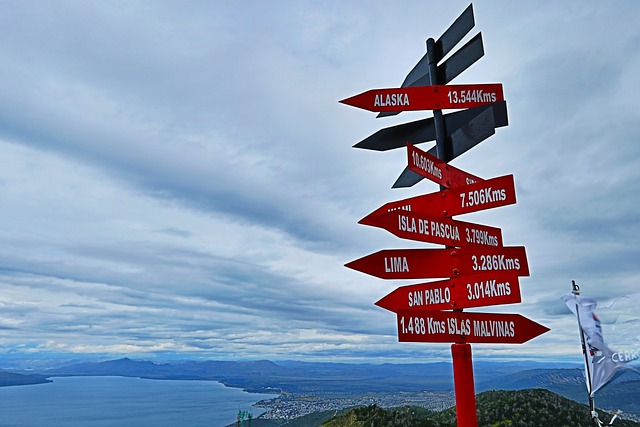Preparing your bags, feeling the anxiety and embarking on an adventure towards a breathtaking destination is an exciting experience. If you are looking for a charming place to explore, Bariloche, Argentina is the perfect destination for you. I'll share everything about how to go, sights, where to eat, where to stay and much more!
Bariloche is known for its stunning natural beauty. The towering peaks of the Andes Mountains, sprawling pine forests and serene lakes create a landscape that seems straight out of a fairy tale. Imagine walking along picturesque trails, exploring enchanted forests and marveling at the majesty of glaciers.
But first, discover the paradise of options that Booking.com has to offer and turn your travel dreams into reality! Making your reservations through our link you will be helping us and you won’t pay anything extra for it 🙂
O booking.com is our trusted website, we made all our reservations through them and now you can also make purchases from passage
In Bariloche, nature reveals itself in its most magnificent form.
Enjoy and also read:
Summer of Bariloche: 5 days itinerary
10 tips for a cheap trip to the end of the world Ushuaia
Chilean and Argentine Patagonia
Where is Bariloche?
Bariloche is located in the region of Patagonia, in the province of Rio Negro, in the southwest of Argentina. Located at the foot of the Andes Mountains, the city is on the shores of Lake Nahuel Huapi, providing a stunning landscape and a privileged location.
How to get to Bariloche
There are different ways to get to Bariloche, depending on your departure location. Here are some common options:
Plane
The most fast and convenient to get to Bariloche is by plane.
O Teniente Luis Candelaria International Airport, located about 15 km from the center of Bariloche, receives domestic and international flights. There are direct flights from Buenos Aires, as well as flights from other cities in Argentina, such as Cordoba and Mendoza. In addition, there are also international flights from some countries, such as Chile and Brazil.
Rent a car with RentCars and guarantee a smooth trip!

Bus
Bariloche has a good road connection with several cities in Argentina and neighboring countries. bus companies like Via Bariloche, Andesmar and Crucero del Norte offer regular trips to Bariloche from cities such as Buenos Aires, Cordoba, Mendoza and Puerto Montt, Chile.
The duration of the bus trip may vary depending on the distance travelled.
Car
If you prefer to travel by car, you can reach Bariloche by road. The city is located along National Route 40, a road that runs throughout the country.
You can rent a car in your hometown and drive to Bariloche, enjoying the stunning views along the way. It is important to be aware of road conditions and properly plan the route.
Train
Although there is no direct train service to Bariloche, you can choose to take the “Patagonian Train” from Viedma to Bariloche. This is a more scenic and touristy option, allowing you to admire Patagonian landscapes during your train journey.
Pay attention to service schedules and availability.
Distances to Bariloche
Porto Alegre to Bariloche: 2,790 km
Buenos Aires to Bariloche: 1,321 km
Florianópolis to Barilochi: 3,241 km
What to do in Bariloche
Cerro Catedral
Located about 20 km from the center of Bariloche, the Cerro Catedral ski resort is a paradise for lovers of winter sports.
With its extensive ski and snowboard slopes, it is an unmissable destination for those looking for fun in the snow. Also, in summer, Cerro Catedral offers hiking trails and incredible panoramic views.
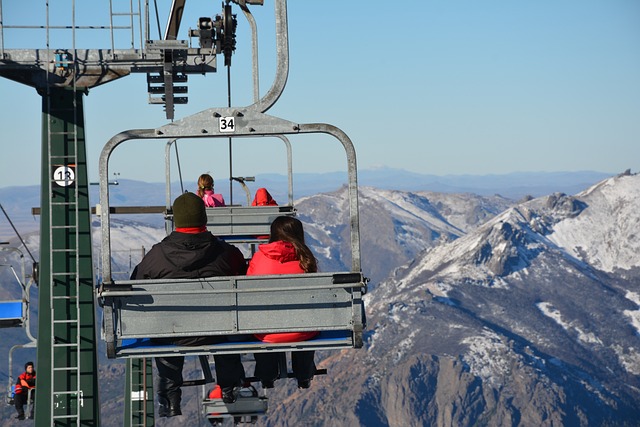
With more than 120 km of ski slopes, Cerro Catedral caters for all skill levels, from beginners to advanced skiers. The slopes are well maintained and varied, with different degrees of difficulty and length. There are designated areas for beginners, where you can learn the basics of skiing, as well as challenging areas for more experienced skiers.
In addition to the slopes, Cerro Catedral offers a series of services and amenities to make the visitor's experience even more pleasant. There are ski and snowboard schools where qualified instructors are available to give lessons and guidance. there is also equipment rental and stores for those who need to buy winter clothes or accessories.
The infrastructure of Cerro Catedral includes restaurants, cafes and bars, where visitors can rest and enjoy delicious meals and hot drinks. There are also rest areas and lounges to relax between snow activities.
In addition to winter sports, Cerro Catedral also offers additional activities such as snowshoe hikes, snowmobile rides and panoramic cable car rides. These options allow visitors to explore the natural beauty of the mountains and enjoy breathtaking panoramic views.
It is important to mention that Cerro Catedral operates during the winter season, which generally runs from June to September, when there is enough snow to practice winter sports. During the remainder of the year, the mountain can also be visited for hiking and enjoying the mountain scenery.
Circuito Chico
Considered the most traditional from Bariloche, Circuito Chico is a tourist circuit that runs for about 60 km around Lake Nahuel Huapi.
One of the most popular stops along the Circuito Chico is Cerro Campanario. At this point, you will have the option of going up to the top of the hill using a cable car.
The eight minutes of ascent will be rewarded with a stunning panoramic view. At the summit, you'll find a pastry shop where you can relax and enjoy the breathtaking scenery of the Andes Mountains and the city of Bariloche in the distance.
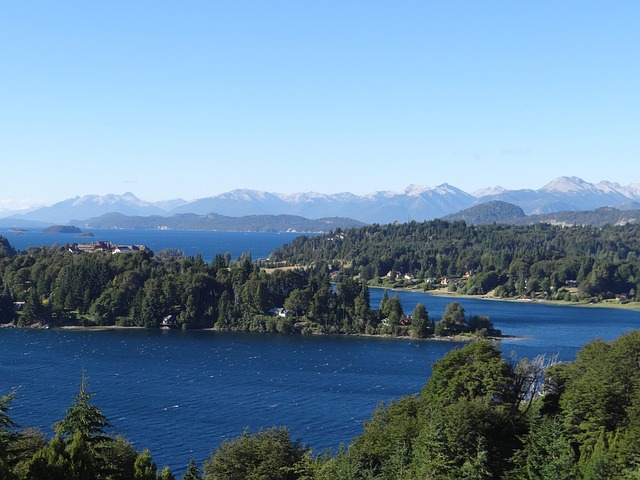
Also, the Circuito Chico takes you to the historic area Hotel Llao Llao, a true icon of Bariloche. With its stunning architecture and prime lakefront location, the hotel is a popular photo spot and a landmark in the area. Next to the hotel is the charming Capela São Eduardo, a small wooden chapel that adds a special charm to the setting.
Along the way, you'll also stop at scenic spots where you can admire breathtaking views of the lake, mountains and surrounding countryside. These stops are great opportunities to take photos and appreciate the natural beauty of Bariloche.
Circuito Chico runs every day of the year, making it an excellent choice for your first excursion in Bariloche. This tour is often included in tour packages, along with the visit to Cerro Catedral.
So be sure to include Circuito Chico in your itinerary and make the most of this unique experience to discover the scenic beauty of Bariloche.
Isla Victoria and Bosque de Arrayanes
Located on Lake Nahuel Huapi, Bosque de Arrayanes is famous for its unique trees with brown trunks and white bark. You can take a boat trip to Isla Victoria, where you will find the enchanting forest.
It is a perfect place to walk, enjoy nature and marvel at the beauty of the forest.
Puerto Blest
Another unmissable boat trip from Bariloche is the trip to Puerto Blest. During the journey, you will navigate through the Nahuel Huapi and Frias lakes, passing through stunning landscapes, waterfalls and mountains.
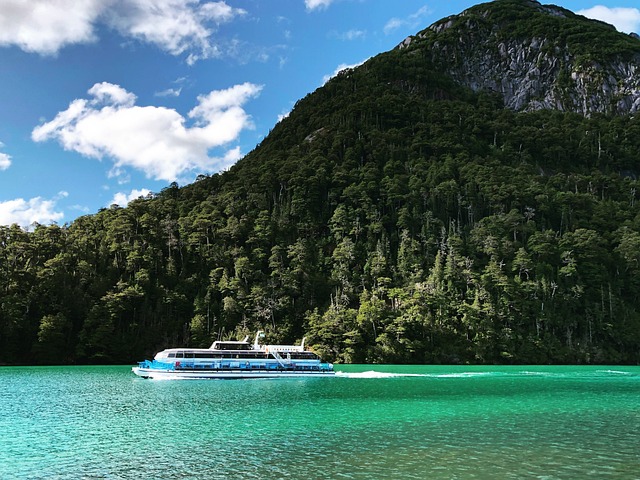
In Puerto Blest, you can explore nature, walk along the trails and visit the famous Salto de los Cantaros, an impressive waterfall.
Salto de Los Cantaros
Salto de los Cantaros is a spectacular natural attraction located near Bariloche, Argentina. It is an impressive waterfall that offers visitors an incredible experience in the midst of the exuberant nature of the region.
Located on the way to Puerto Blest, Salto de los Cantaros is a real highlight along the boat ride to this enchanting spot. The waterfall is formed by the Blest River, which flows from the mountains in a series of spectacular waterfalls.
As you approach the Salto de los Cantaros, you will be greeted by the relaxing sound of the water crashing down and the breathtaking view of the natural spectacle before your eyes. The waterfall has a considerable height and the water falling among the rocks creates a magical and refreshing atmosphere.
One of the best ways to enjoy the Salto de los Cantaros is to stop during the boat ride to Puerto Blest. Many boats allow visitors to disembark to explore the area around the waterfall and take stunning photos. It is a unique opportunity to get close to nature and witness the grandeur of this natural spectacle.
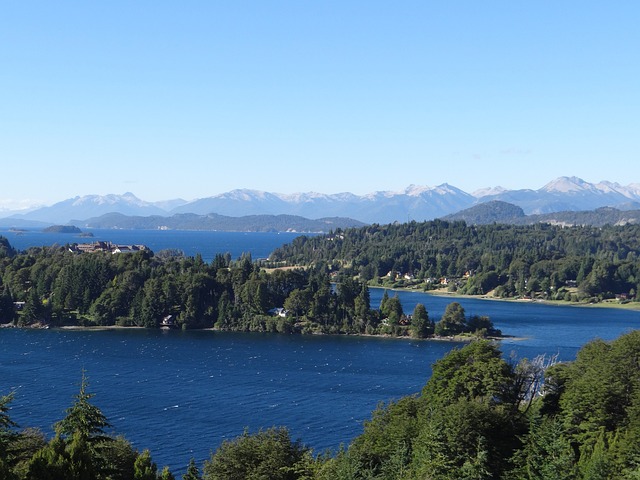
To get to Salto de los Cantaros, you can choose to take a boat trip from Bariloche. Boats take visitors on a scenic tour of Nahuel Huapi and Frias lakes, passing through stunning landscapes to reach Puerto Blest. Along the way, the boat makes a strategic stop at Salto de los Cantaros, allowing tourists to take the time to explore the waterfall and admire its beauty.
It is worth mentioning that, to visit Salto de los Cantaros, it is usually necessary to pay an entrance fee for the boat trip to Puerto Blest, which includes a stop at the waterfall. This fee is intended to cover the costs of conserving the natural area and ensuring that it is preserved for future generations.
Colonia Suiza
Located a few kilometers from Bariloche, Colonia Suiza is a charming Swiss village that preserves traditions and culture. You can visit the local craft fair, try typical Swiss dishes and enjoy the cozy atmosphere.
It is a great option to explore the local culture and taste gastronomic delights.
One of the main attractions of Colonia Suiza is its craft fair, which takes place on weekends and holidays. The fair is a true paradise for craft lovers, with a variety of local products such as woolen clothing, ceramics, jewelry, sweets and much more. It is the perfect place to find unique and authentic souvenirs from the region.
In addition, Colonia Suiza is known for its delicious cuisine. There are several restaurants and grills serving typical Argentine dishes, such as the famous beef and lamb barbecue. You will also find Swiss food options such as fondue and raclette, as well as delicious baked goods such as homemade breads and pastries.
Where to eat in Bariloche
El Boliche de Alberto
This traditional Argentinian restaurant is famous for its delicious cuts of meat, including the famous Chorizo steak and succulent Patagonian lamb. Side dishes usually include baked or fried potatoes.
The average price for a complete meal, including meat, side dishes and drink, ranges from 800 to 1200 Argentine pesos (approximate values).
Butterfly pub and bar
If you're looking for a more refined dining experience, butterfly it is an excellent option. This restaurant offers creative dishes of contemporary cuisine, with Argentinean and international influences.
You can find options like Patagonian salmon, smoked trout, risottos and delicious desserts. The average price for a complete dinner with starter, main course, dessert and drink is around 1500 to 2000 Argentine pesos.
The Marmite
If you are a fan of Swiss cuisine, La Marmite is the place to be. This restaurant offers classic Swiss dishes such as cheese fondue, raclette and cheese and potato dishes. In addition, they also serve Argentinian dishes such as bife de chorizo.
Prices vary according to the dish chosen, but a complete meal can cost an average of 1000 to 1500 Argentine pesos.
Rap Nui
If you are a chocolate lover, you cannot miss the famous Rapa Nui chocolate shop in Bariloche. They offer a wide range of artisanal chocolates, truffles, ice cream and other delicious desserts.
Prices vary depending on the type of chocolate and the amount you want to buy, but you can find options starting at 50 Argentine pesos.
manush
For vegetarians and vegans, Manush is an excellent option in Bariloche. This restaurant offers healthy and delicious dishes, with options such as veggie burgers, salads, wraps and vegan desserts.
Prices are generally affordable, averaging 300-500 Argentine pesos per meal.
Where to stay in Bariloche: best hotels
Llao Llao Hotel & Resort
Regarded as one of the best luxury hotels in the region, Llao Llao Hotel & Resort offers a world-class lodging experience.
Located in a stunning setting, between mountains and lakes, the hotel offers elegant rooms, a spa, swimming pools, a golf course and a variety of dining options.
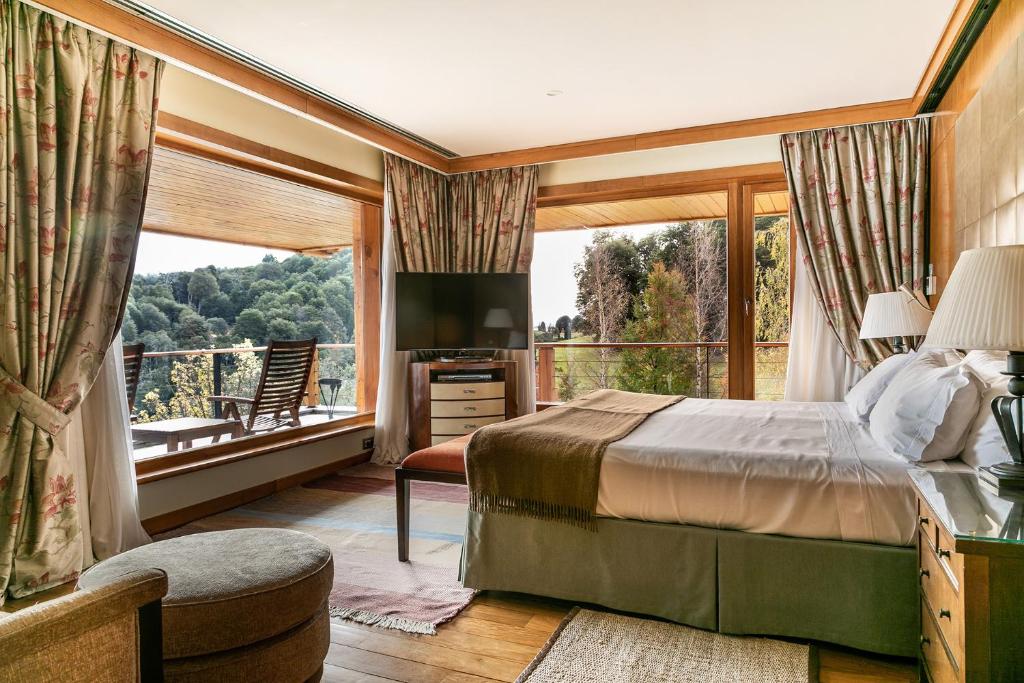

Hotel Edelweiss
Located in downtown Bariloche, Hotel Edelweiss is known for its warm hospitality and cozy atmosphere.
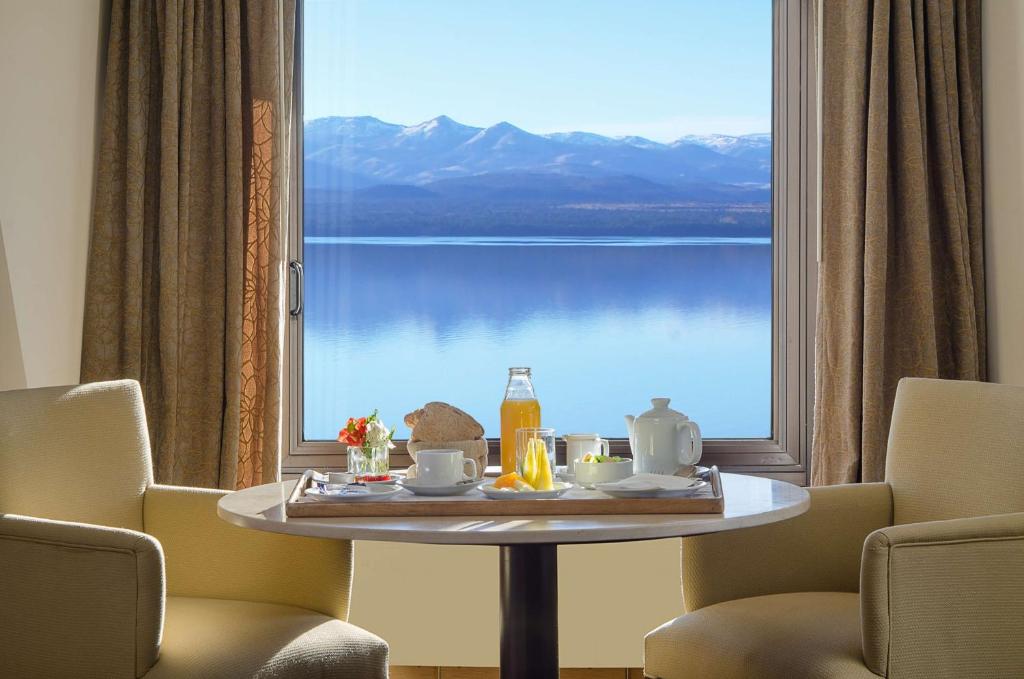
The hotel offers comfortable rooms, restaurant, bar, gym and spa. Its central location allows easy access to the main sights of the city.
Hotel Cacique Inacayal
Situated on the shores of Lake Nahuel Huapi, Hotel Cacique Inacayal offers stunning views and a relaxing atmosphere.
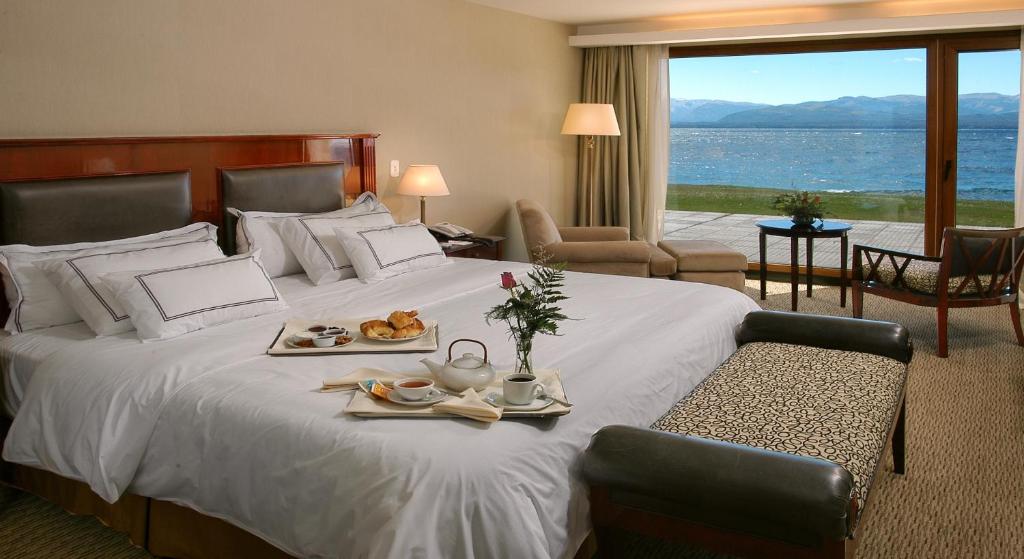
The rooms are spacious and comfortable, and the hotel has a heated pool, spa, restaurant and bar. Its privileged location allows guests to enjoy the natural beauty of the area and explore nearby attractions.
Charming Luxury Lodge & Private Spa
Located in a quiet area, surrounded by woods and overlooking Lake Nahuel Huapi, the Charming Luxury Lodge & Private Spa is a perfect option for those seeking privacy and exclusivity. The lodge offers luxurious chalets, private spa, gourmet restaurant and personalized service.
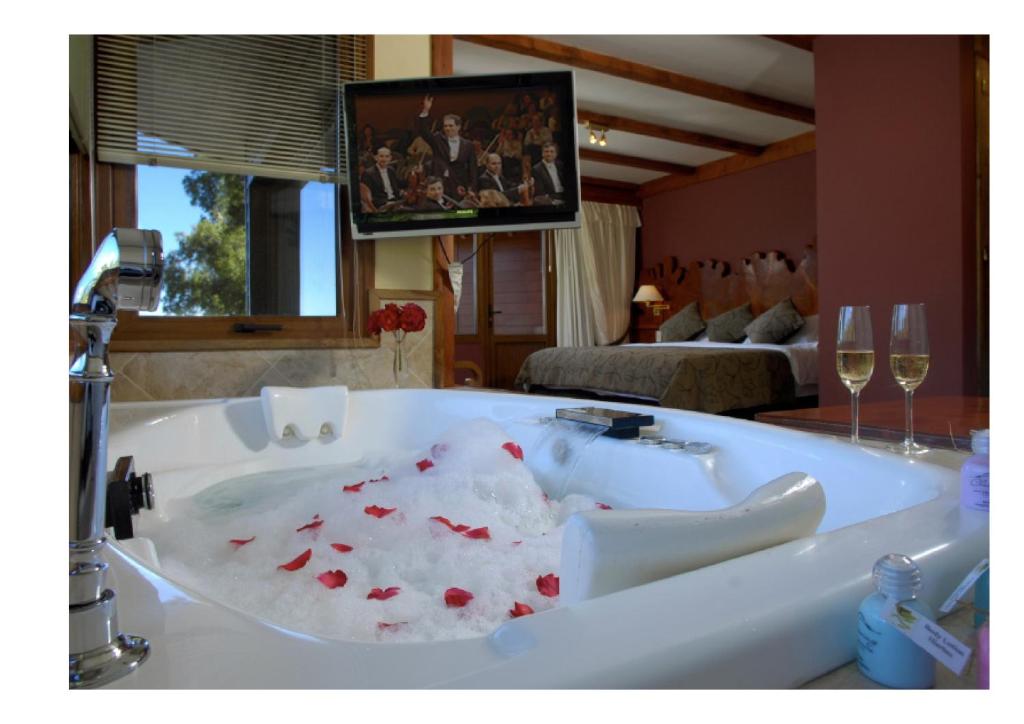
Hosteria El Condado by Nordic
Located in San Carlos de Bariloche, Hosteria El Condado by Nordic offers a cozy atmosphere with spacious and uniquely furnished accommodation with beautiful views of the lake or the mountains. Preserving harmony with nature, the hotel has a charming architecture that combines wood and stone.
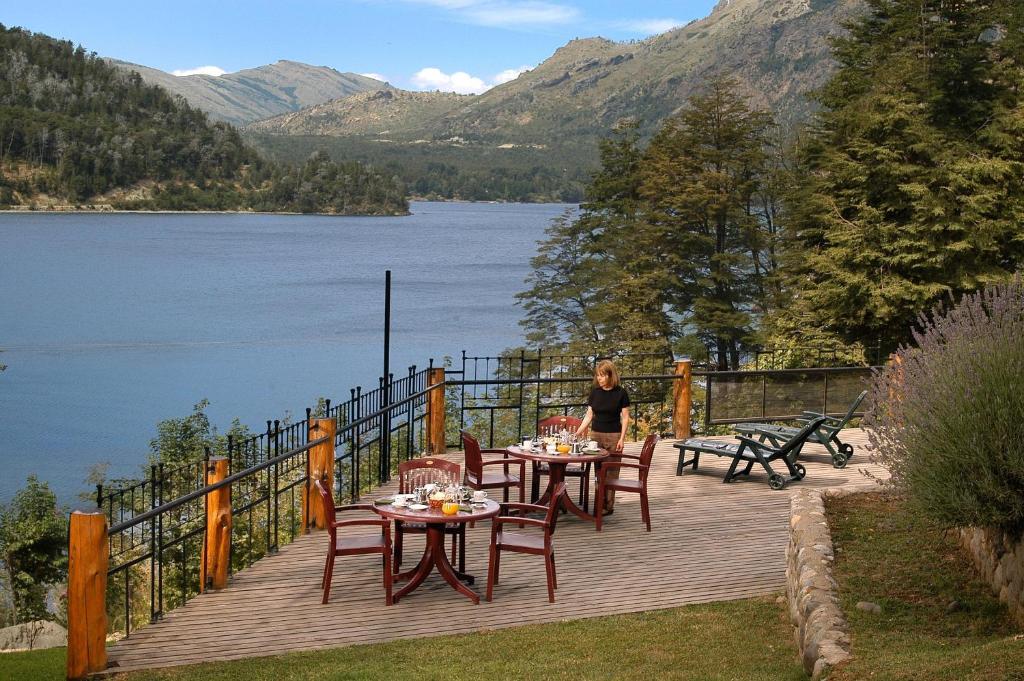
Guests at Hosteria El Condado by Nordic can enjoy a bar overlooking Lake Gutierrez and a shared lounge with a large fireplace. They can also relax in the garden.
Tips for first-time visitors to Bariloche
Enjoy winter sports: Bariloche is famous for its ski resorts, so if you're visiting during the winter season, be sure to try skiing or snowboarding in the mountains. Travelers recommend renting suitable equipment and taking classes for beginners.
Do the Chico Circuit: Circuito Chico is a scenic drive that offers breathtaking views of Lake Nahuel Huapi and the surrounding mountains. Travelers suggest renting a bike or hiring a tour to explore this circuit and stop at points like Cerro Campanario and Hotel Llao Llao.
take boat trips: Bariloche is surrounded by stunning lakes and rivers, so take the opportunity to take boat trips and explore the area's natural beauty. Travelers suggest taking a trip to Victoria Island and Bosque de Arrayanes, known for its unique trees.
Explore the surroundings: In addition to Bariloche, the surroundings also offer beautiful landscapes and attractions. Travelers recommend visiting the Nahuel Huapi National Park, Cerro Tronador and the town of Villa La Angostura, which is just a short drive from Bariloche.
Be prepared for climate change: Bariloche can have significant climate variations, so it's important to be prepared for different conditions. Travelers advise bringing weather-appropriate clothing such as warm coats, waterproof clothing, and extra layers.
Book in advance: Bariloche is a popular tourist destination, especially during the winter season, so it is advisable to make advance reservations for accommodation, tours and activities to ensure availability and the best prices.
Where to rent winter clothes in Bariloche
All rental stores usually have skis, snowboards, poles, boots and helmets available for rent. In addition, you will find a variety of winter clothing such as jackets, pants, gloves and goggles.
Xtreme School
Address: cathedral hill base, total ski building, R8401 San Carlos de Bariloche, Río Negro, Argentina.
Values for rent clothing BRONZE CATEGORY:
complete snow suit (jacket-trousers and gloves). Daily $ 11.000.- clothes by item $ 5.000.
GOLD CATEGORY:
complete snow suit (jacket-trousers and gloves) FACE NORTE / COLUMBIA Daily $ 34,700.
In addition to these items, they rent glasses, boots, equipment for extreme sports and give ski or snowboard lessons.
blue pro
In this store they rent equipment, rent and sell warm clothes. Pants, jacket, boots and gloves $ 450 per adult and $ 350 per child (around these values, varying according to the quantity, model and brand of clothing).
Address: San Martín 127 Local 13, R8400 San Carlos de Bariloche, Rio Negro, Argentina
When is the best time to go to Bariloche?
Winter (June to September): Winter is the ski season in Bariloche, when the mountains are covered with snow and the ski resorts are in full operation.
If you are passionate about winter sports such as skiing and snowboarding, this is the best time to visit. The snowy landscapes are breathtaking and there is a lively atmosphere in the mountains. However, this is the peak season and there may be greater demand for accommodation and activities, as well as higher prices.
But of course you can go any time of the year as there will always be activities and places to explore!
Is it cheaper to go to Chile or Bariloche?
In general, Bariloche, Argentina can be more affordable in terms of travel costs, while Chile can be more expensive, especially in destinations like Santiago or distant regions.
However, actual costs may vary and it is important to research and compare options to gain an accurate understanding of the costs involved. Checking exchange rates is also recommended, as this can influence travel costs and of course, don't forget to take care of airfare promotions!
How much does it cost to go from Brazil to Bariloche?
In winter the value is around R$ 2,800.00 (high season), while in the low season it can reach R$2,200.00.
What is the cheapest date to go to Bariloche?
During the low season between the months of December to March.
What should I know before going to Bariloche?
Before traveling to Bariloche, it is important to consider the climate, the season, the local currency, the language spoken, the need for travel insurance, the necessary documents, the transport options, the main tourist attractions, the local gastronomy and the contacts of the embassy or consulate.
Check up-to-date information, plan ahead and enjoy your trip.
How much do you spend per day in Bariloche?
Average cost of a trip to Bariloche in winter (high season): R$1,000.00. In low season, it costs around R$800.00. That's because hotels are cheaper and you probably won't need to rent clothes for the snow.
Activity prices vary, but on average, expect to spend R$100.00 to R$1,000.00 per activity, depending on the complexity and duration, which can increase your expenses at the end of the trip.
What currency is used in Bariloche?
The official currency in Bariloche and Argentina is the Argentine peso (ARS). It is advisable to have Argentine pesos on hand during your stay in Bariloche, as not all establishments accept other foreign currencies.
How many days is ideal in Bariloche?
Generally stay at least 4 to 5 days to properly explore the main attractions and enjoy the activities available in the area.
With that time, you will have the opportunity to visit the main tourist attractions, such as Cerro Catedral, Circuito Chico, Nahuel Huapi National Park and Cerro Otto. In addition, you can enjoy outdoor activities such as skiing, snowboarding, hiking, boating and even relaxing on the beaches of the lakes.
How is the snow in Bariloche in August?
In August, Bariloche usually has a good amount of snow in the ski areas, making this month a popular time for winter sports enthusiasts. However, the amount of snow and conditions can vary from year to year as they depend on specific weather conditions.
How to get from Buenos Aires to Bariloche?
Options to go from Buenos Aires to Bariloche:
Plane: Direct flight from Buenos Aires International Airport to Bariloche International Airport, approximately 2 hours travel time.
Bus: Travel by bus from Buenos Aires to Bariloche, lasting 18 to 22 hours, depending on the type of bus and itinerary.
Car: Travel by car along Ruta Nacional 3 and Ruta Nacional 237, lasting about 20 to 24 hours, planning stops for rest and supplies.
When does it snow in Bariloche?
Snow usually occurs during the winter, which runs from June to September. The snow season in Bariloche is most consistent between mid-June and mid-September, with July and August the months when the presence of snow is more frequent and guaranteed.
What to do in Bariloche in Winter?
Activities in Bariloche during the winter:
- Ski and Snowboard at ski resorts such as Cerro Catedral.
- Ride the Circuito Chico to enjoy the snowy landscape.
- Sleigh rides with huskies or malamutes.
- Snowmobile tours to explore the snow.
- Visit Cerro Campanario for panoramic views.
- Relax in spas.
- Taste the region's famous chocolates.
- Snowshoeing on specific trails.
- Taste the local cuisine, such as Patagonian trout and fondue.
How many degrees does it get in Bariloche in winter?
During the winter in Bariloche, average temperatures can fluctuate, but are generally quite low. During the day, temperatures are usually between 0°C and 8°C, and during the night they can drop to negative values, ranging from -5°C to -15°C.
When do the ski resorts open in Bariloche?
Ski resorts in Bariloche generally open during the winter, between late June and early July, and run until late September or early October. However, exact opening dates may vary from year to year. It is important to check the updated information of the ski resorts to confirm the availability of snow and activities.
During the ski season, the resorts offer cable cars, ski slopes and related services. It is advisable to plan your visit in advance, especially on weekends and holidays, and consider booking accommodation and ski passes in advance.
Learn all about Bariloche
Did you like our tips?!
Read too:
